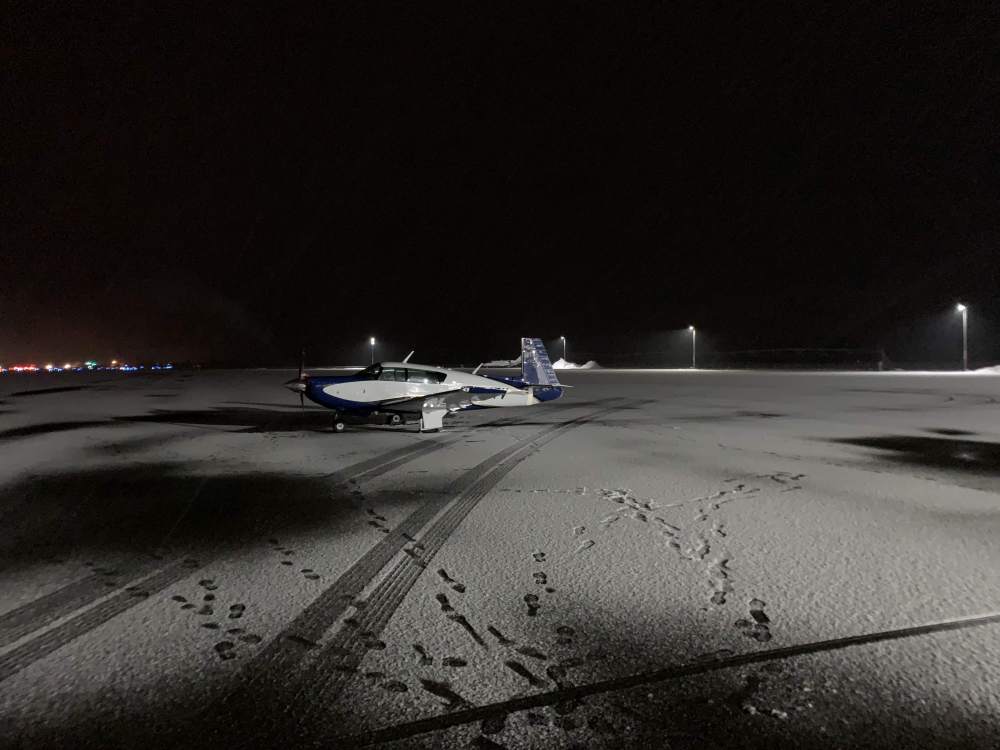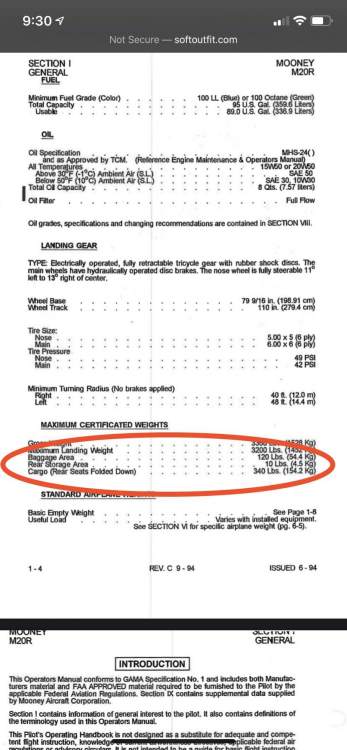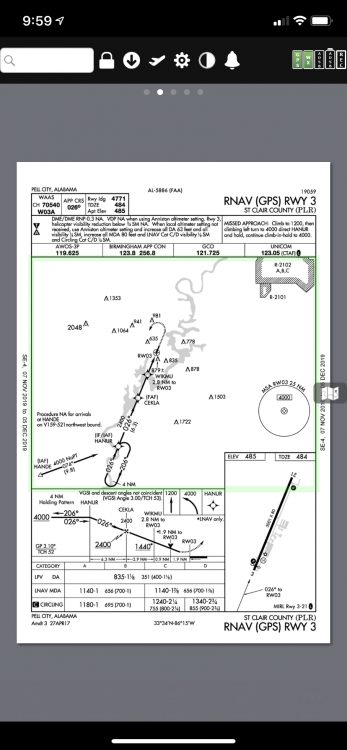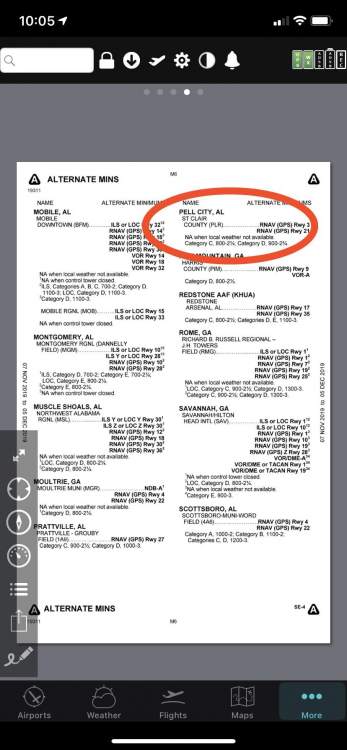-
Posts
2,769 -
Joined
-
Last visited
-
Days Won
7
Content Type
Profiles
Forums
Blogs
Gallery
Downloads
Media Demo
Events
Everything posted by M016576
-
I went with the AXP340...just about a slide in replacement for my old king unit, only had to run a single wire to the IFD440. Total install cost was $200. (Unit was ~$2K)
-
Don’t mention that to Peter Garmin!
-
That’s not the dynamic chart...that’s the IFR low chart. I’d expect the IFR low chart to show all the updates. the garmin dynamic chart is a different base layer you can select, which is an aggregate of highly configurable options. One main advantage is that the labels will always be upright for you... where as with the base layer charts, they are static based on north. I believe foreflight has a similar type of dynamic chart, too. edit: I don’t use garmin’s app so if anything is not accurate in the above text, please feel free to jump in.
-
Oh... and if someone gave me 100K and said “invest this 100K in your panel”... I’d sell my Missile for 150K, and buy a bravo or 252 with encore upgrade (for big time U/L upgrade) and buy that... then pocket the remaining 30-50K, as those planes would probably already have a nice avionics suite!
-
you’re exactly right... If the OP does nothing to the panel but adding a waas GPS and ads-b transponder (say.. roughly 10K in total for a used 430W and KT-74, which includes install).... they will *legally* be able to fly to all the same capabilities as someone that does spend 100K on their panel (full garmin rig- autopilot, transponder, PFD, mfd). some will argue that the extra 90K of investment is worth it. Some will argue that it is not. But the fact remains, both aircraft will be treated the same by ATC. (M20P/G)
-
It’s times like this, where I really love my Missile. 2 days before Xmas, fly 4 hours to spend the holidays with my folks, shoot an RNAV approach in the snow... true holiday spirit... mooney style! now... Snow Harder! Tomorrow’s gunna be a powder day, I can feel it!!
- 4 replies
-
- 15
-

-

-
Same with my IFD440, which I’ve had since 2015
-
Sun river is no joke. I’ve landed there a few times and been surprised... and not in a good way. although in the summer time, it’s absolutely amazing... I love the fleet of bikes they keep at the airport, so you can ride to wherever you may need to get to... better than any crew car around those parts!!!!
-
eBay has them every once in a while too... worth checking there
-
Oh no.... what a loss. He was a tremendous member of this community, and we were all better for having him here. Prayers...
-
Sad someone would think to fly their family/kids into that kind of weather in a light civil.
-
And most of the time they involve a climb on runway heading followed by some vectors.
-
I’m guessing that passenger was not one of @Marauder ‘s girls!
-
According to my Missile STC, there are some nose gear components that were swapped out with later model components to allow for the GW increase to 3200... I think it’s a thicker walled tubular structure in the nose gear components, if memory serves me correct. The components that were replaced are listed in the Missile STC paperwork... I may have already posted those here somewhere...
-
That makes sense, and I get that...But what’s stopping the cargo area cargo from moving into the baggage area in flight? (Other than good judgement and packing skills)
-
I love that it’s flexible... but they might as well just drop that 120lb restriction out of there entirely and just go with 340 for all circumstances. Unless, of course, that would result in material failure... then the total “cargo” number should probably be a bit more restrictive (in CG or Weight, or both). my 3rd guess is that their is some unknown FAA way of calculating central CG for a compartment, that is not based on point loading for the weakest point in said compartment. So when mooney calculated their center point for the cargo area they found it wasn’t as strong as the center point of the area with the seats folded down, this the difference in weight restrictions.... just (another) guess though.
-
I understand that part- but what doesn’t make sense to me is how the book states “cargo- seats folded down-340lbs” but doesn’t specify a Moment arm for those 340 lbs.... by that logic, you could conceivably load all 340 lbs in what is normally the “seats up” baggage area and still be legal so long as the seats are folded down... thus de-bunking the strength of the baggage compartment floor. I think where I’m fuzzy on the logistics is that it seems to me like if you fold down the seats, the entire load could potentially shift all the way aft, the “overloading” the supposedly fragile baggage compartment floor. Am I misreading this? Or is there something else in the load schedule that I’m missing? do the seats in an ovation fold down over the normal floor in the baggage area? In my J, I just remove them entirely if I don’t want them in there any more...
-
technically, according to the POH, that “gigantic baggage compartment” still has a 120lb maximum weight limit, though. seems silly to me- as they account for rear passenger weight when the seats are folded down (“cargo, seats folded down-340”), which is 170 per seat.... but doesn’t specify the moment arm for loading in that configuration- just a maximum weight. That would lead the test pilot in me to want to go put 340lbs in the baggage compartment with the rear seats in the up position, but unoccupied... which is probably what mooney did during their testing on the long body. Either that, or they didn’t test a cargo loading at all with the seats folded down... but put 120lbs in the baggage area and the rest (perhaps a 220lb body?) in the rear seats. Or maybe just used 340lbs from the back seat testing and left the cargo bay empty- thus potentially avoiding some recertification test efforts. either way, the placard limit exists. oh, and -A-, you forgot slightly faster and a greater useful load, when comparing a missile to an Ovation.
-
Yes, your old unit still gets sent back to the factory, which they keep.
-
I love my ‘08 M3 with the 6MT. naturally aspirated and manual transmission
-

IFR Approach legal without ceiling on AWOS?
M016576 replied to Oldguy's topic in Miscellaneous Aviation Talk
I get it- and I understand that the Non-standard alternate instructions have absolutely no bearing on whether or not one can shoot the approach.... I’m just saying that based on the limited information we have, that appears to be related to the reason why the approaches were closed (even though they shouldn’t have been based on just that Awos notam). It’s a mystery still, for sure! -

IFR Approach legal without ceiling on AWOS?
M016576 replied to Oldguy's topic in Miscellaneous Aviation Talk
I 100% agree with you here- it seems like a 1-off action by approach with no clear regulation that’s driving the approaches closed. I’d want to know why, too. -

IFR Approach legal without ceiling on AWOS?
M016576 replied to Oldguy's topic in Miscellaneous Aviation Talk
Check out the notes on the approach plate- you can use Anniston’s ATIS for altimeter in place of the Awos altimeter. I just checked the non-standard alternate notes and look at this gem.... my guess is that approach is using this note to close the approach. I would think that note would only apply to the fields approaches to be used as an alternate though... otherwise I’d expect that it would be listed on the plate themselves, like most other major restrictions (like radar required, etc). edit: I wonder if approach just decided to close the approaches because of that note in the alternate minimums... just to reduce risk. It Isn’t a part 91 requirement to close the approaches... and reading the plate doesn’t seem to indicate that the approach should be closed for the Awos being out... if anything- it gives an option by using Anniston. -

IFR Approach legal without ceiling on AWOS?
M016576 replied to Oldguy's topic in Miscellaneous Aviation Talk
I’m assuming you’re talking about commencing at an uncontrolled field (no atis, no tower, just Awos)...Yes under part 91 for “no ceiling on Awos” for the reasons covered above (can always shoot (start) an instrument approach under part 91. It’s just whether or not you see the landing environment when you get to minimums that’s the question. what do you mean “it is notam’ed out”? the AWOS is NOTAM’d out? If so, approach can pass the closest wx if you need it. You can still always start the approach under part 91. if you mean the “approach is notam’d out”... then you cannot legally start the approach under IFR with the intent to land(unless it’s an emergency situation).... you may be able to fly the approach ground track VFR if an approach is notam’d out. Of course you’d need to be VMC for that, and possibly be required to break off the approach early.. That would be something to coordinate with approach control. -

ASI discrepancy Aspen vs. steam backup
M016576 replied to Bob_Belville's topic in Miscellaneous Aviation Talk
Aspen GS comes from its own GPS, the winds do too (none of the speeds displayed on the Aspen come from the panel mount gps, if you have one). I think the winds are reverse calculated by comparing the calculated TAS to the GS. Regardless... 2 ground speed calculations in your cockpit- one is on the Aspen, a separate one on the panel mount GPS. Compare both with the TAS’s you’ve calculated and you’ll find your smoking gun. Using your screenshot above- it appears to be the mechanical airspeed indicator that’s in error. If you do the calculations more times, you’ll find a higher confidence as to what instrument is off... but it looks to me based on that one screenshot to be the mechanical. would probably be best to do the TAS calculations using 3 legs (kind of like a speed course) that should help to factor out winds a bit.






